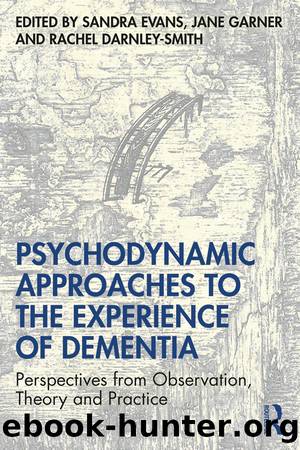Psychodynamic Approaches to the Experience of Dementia by Sandra Evans;Jane Garner;Rachel Darnley Smith;

Author:Sandra Evans;Jane Garner;Rachel Darnley Smith;
Language: eng
Format: epub
Publisher: Taylor & Francis (CAM)
Published: 2020-06-15T00:00:00+00:00
Developmental research
Given the importance of attachment in dementia, what does research have to tell us about what may help with anxieties and insecurities linked to this? Van Assche et al. (2013) point out the need to link the study of attachment in dementia with the extensive research on attachment at the other end of the lifespan and, as I shall discuss, the learning from developmental research has implications for our thinking about how to respond to the attachment needs of people with dementia. In order to explore this, we need to begin with the earliest attachment relationships we form, looking at research which helps us to understand how relationships in early life are established securely and what relevance this may have to thinking about dementia.
The fundamental message of developmental research in attachment is the importance for the infant of contact with the caregiverâs mind, and of experiencing the caregiverâs âmind-mindednessâ, which are crucial for cognitive and emotional development and for establishing secure attachment. Ainsworth (1978) demonstrate that parental sensitivity and responsiveness to infant affect is a key determinant of secure attachment; the infant needs to encounter a mind, a mindfulness of its own internal state in its primary care givers: âit is not gratification of need that is at the heart of bonding, rather, it is the caregiverâs capacity to create in her mind the infantâs mental stateâ (Fonagy et al., 1993). This is not only at the heart of secure attachment, but also is the key to the infantâs healthy emotional and cognitive development. Indeed, developmental researchers, such as Tronick (2004), have shown that when the infantâs caregiver does not respond to their attempts to engage them, the coherence and complexity of their self-representation is disrupted and they move closer to states of both emotional and cognitive disorganisation, turning away and withdrawal (see also Fonagy et al., 2007; Beebe, 2015). This description of the infantâs reaction to the disengagement of its object is reminiscent of observational work in dementia care settings, where the âwarehousingâ of patients who, left for long periods without personal interaction, show a similar picture of disengagement and withdrawal (Davenhill et al., 2003).
Attachment needs are activated by dementia, with progressive cognitive impairment likely to cause both cognitive and emotional dis-integration in the context of the loss of opportunity for shared understanding and âinter-subjectivityâ. Partners of people with dementia often express the impact of the loss of emotional contact and reciprocal communication within the couple, and one researcher writes: âthe feeling of the loss of the partner is associated with the loss of sharing or interaction with the partnerâ. Some carers expressed this loss of communication as: âif only I knew what he/she was thinkingâ (Bull, 1998; see also Lewis, 1998; Murray et al., 1999). The evidence from developmental research of the importance of mutuality and âinter-subjectivityâ (Fonagy et al., 2007) for security of attachment may therefore have particular implications for people with dementia, whose attachment relationships are changing as anchorage in their familiar relational and social world is progressively under threat.
Download
This site does not store any files on its server. We only index and link to content provided by other sites. Please contact the content providers to delete copyright contents if any and email us, we'll remove relevant links or contents immediately.
| Administration & Medicine Economics | Allied Health Professions |
| Basic Sciences | Dentistry |
| History | Medical Informatics |
| Medicine | Nursing |
| Pharmacology | Psychology |
| Research | Veterinary Medicine |
Bioenergetica by Alexander Lowen(1123)
Noise: A Flaw in Human Judgment by Sunstein Cass R. & Sibony Olivier & Kahneman Daniel(968)
The Data Detective by Tim Harford(945)
The Child in You by Stefanie Stahl(883)
Chatter by Ethan Kross(799)
The Science of Rapid Skill Acquisition by Peter Hollins(639)
Freedom by Sebastian Junger(633)
No Bad Parts by Richard C. Schwartz(604)
The Montessori Baby by Simone Davies(566)
Evolution Gone Wrong: The Curious Reasons Why Our Bodies Work by Alex Bezzerides(560)
The Quantum Psychiatrist: From Zero to Zen Using Evidence-Based Solutions Beyond Medication and Therapy by Biswas Dona(551)
Maps of Meaning: The Architecture of Belief by Jordan B. Peterson(551)
The Science of Self-Learning: How to Teach Yourself Anything, Learn More in Less Time, and Direct Your Own Education (Learning how to Learn Book 1) by Peter Hollins(522)
Anxiety For Dummies by Charles H. Elliott & Laura L. Smith(512)
Sadomasochism and the BDSM Community in the United States by Stephen K. Stein(498)
Disconnected by thomas Kersting(482)
Why Sex Doesn't Matter by Olivia Fane(480)
The Mechanics of Passions: Brain, Behaviour, and Society by Alain Ehrenberg(480)
Jung - The Key Ideas: Teach Yourself (TY Philosophy) by Ruth Snowden(468)
